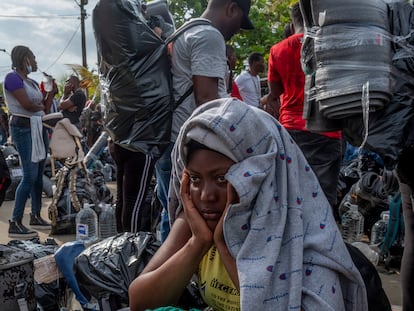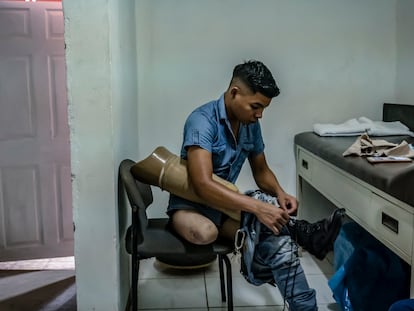The Darién Gap and promise in the Americas
Even among those migrants who survive the jungle, most will not make it to their dream in the US as the journey North is perilous and the prospects for entering the country are narrower than they have ever been. But the allure of America remains powerful

In a time when Americans increasingly worry about our country’s future for deeply divergent reasons – some fearing growing diversity and others worried an equitable distribution of power will never come to pass – I found two oddly interrelated reservoirs of belief in the United States earlier this month that bear mention as Hispanic Heritage Month draws to a close.
The first was in a most unlikely place I visited last week – Canaán Membrillo, Panamá, a ramshackle indigenous town of 300-plus residents on the edge of the Darién Gap, one of the most impenetrable stretches of jungle in the world along the Panamá-Colombia border, and the epicenter of an accelerating humanitarian crisis unfolding in the Americas.
Human mobility is increasing at unprecedented rates in a hemisphere battered by regime-driven state failures in Venezuela, Cuba, Nicaragua, and Haiti; the economic, social, and political aftershocks of Covid-19; and the ravages of the climate crisis. Nowhere is that more obvious than in Canaán Membrillo. Last decade, less than 95,000 migrants passed through the Darién. Last year, 134,000 made the journey. Last month nearly 50,000 did. This month, Canaán Membrillo is receiving anywhere from 1,500 to 2,000 new migrants daily.
People are on the move for myriad reasons – basic survival, fleeing political persecution, seeking safe harbor from criminal violence, wanting to reunite with family, or pursuing a better life for them and their families. Despite the variety of motivations most, according to the men, women, and children with whom me and my colleagues spoke, share at least one thing in common – a core belief that the chance at a better life awaits them in the United States, if they can just get here.
A belief so strong they, like the generations of migrants who have come before to shape who and what we are today, are willing to risk everything. Even among those who survive the Darién, most will not make it to their dream in the United States as the journey North is perilous and the prospects for entering the country are narrower than they have ever been. But the allure of America remains powerful.
And for good reason if you consider the other reservoir of belief in the United States that recently caught my eye – a study timed to the annual celebration of Hispanic Heritage Month that highlights the economic dynamism of US Latinos. The report by the Latino Donor Collaborative shows that US Latinos, if we constituted a stand-alone economy, would be the world’s fifth largest economy.
The $2.8 trillion in economic activity of US Latinos in 2020 was fifth only to the gross domestic products of the United States, China, Japan, and Germany. The US Latino economy is roughly equivalent to the combination of Latin America’s two largest economies – Brazil with a gross domestic product (GDP) of $1.61 trillion and Mexico with a GDP of $1.29 trillion, despite the 62.1 million US Latinos being less than one-fifth the combined population of Brazil and Mexico (341.5 million).
Driven by a combination of factors – population growth, increasing educational attainment, and record levels of entrepreneurship, among others – and despite obvious challenges, including persistent discrimination, the United States remains a land of opportunity for US Latinos. Something US Latinos and our brethren across the Americas understand. More than 60% of US Latinos explicitly believe they can “live the American Dream” and according to Pew Research, more than two thirds of US Latinos are somewhat or very optimistic about the country’s future compared to 56% overall.
The success enjoyed by Latinos in the United States carries with it an important lesson that relates back to the historic number of people on the move across the Americas. Like anyone else, Latinos can flourish when presented with opportunity in an environment that provides basic guarantees and the rule of law. It is the absence of those conditions in too many countries across the Americas – North and South of the Darién – that is fostering the conditions forcing more and more people to look for a survivable present and better future elsewhere.
Authoritarian regimes like those of Cuba, Venezuela, and Nicaragua are the most obvious perpetrators of snuffing out both opportunity and the rule of law, but sadly they are not alone. Captive economies built, at least in part, on the de facto expulsion of people and the capture of the remittances they send home like those of Northern Central America and Southern Mexico are also holding back the potential of millions of people to prosper in their communities of origin.
Thanks in no small part to the drive and determination of US Latinos, the promise of America endures. As we conclude Hispanic Heritage Month, we must hope the example of America, however imperfect, and the success of US Latinos can inspire not only risk takers looking North, but a new generation of civic, political, and economic leaders across the Americas to foster the conditions needed for populations to live and prosper right where they are.
Tu suscripción se está usando en otro dispositivo
¿Quieres añadir otro usuario a tu suscripción?
Si continúas leyendo en este dispositivo, no se podrá leer en el otro.
FlechaTu suscripción se está usando en otro dispositivo y solo puedes acceder a EL PAÍS desde un dispositivo a la vez.
Si quieres compartir tu cuenta, cambia tu suscripción a la modalidad Premium, así podrás añadir otro usuario. Cada uno accederá con su propia cuenta de email, lo que os permitirá personalizar vuestra experiencia en EL PAÍS.
¿Tienes una suscripción de empresa? Accede aquí para contratar más cuentas.
En el caso de no saber quién está usando tu cuenta, te recomendamos cambiar tu contraseña aquí.
Si decides continuar compartiendo tu cuenta, este mensaje se mostrará en tu dispositivo y en el de la otra persona que está usando tu cuenta de forma indefinida, afectando a tu experiencia de lectura. Puedes consultar aquí los términos y condiciones de la suscripción digital.
More information
Archived In
Últimas noticias
Most viewed
- Reinhard Genzel, Nobel laureate in physics: ‘One-minute videos will never give you the truth’
- Oona Chaplin: ‘I told James Cameron that I was living in a treehouse and starting a permaculture project with a friend’
- Pablo Escobar’s hippos: A serious environmental problem, 40 years on
- Charles Dubouloz, mountaineering star, retires at 36 with a farewell tour inspired by Walter Bonatti
- Why we lost the habit of sleeping in two segments and how that changed our sense of time










































